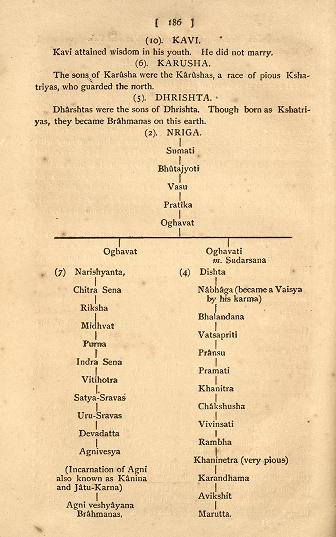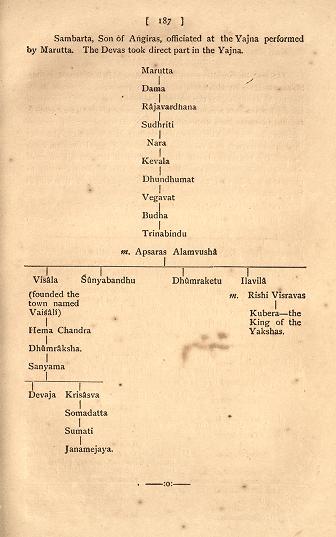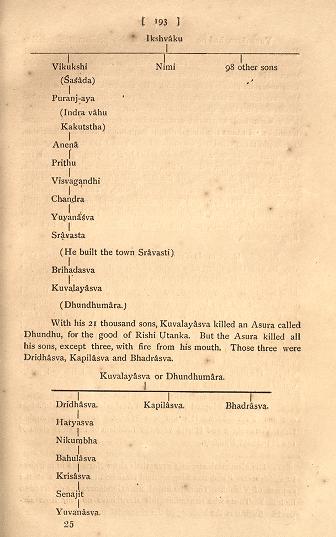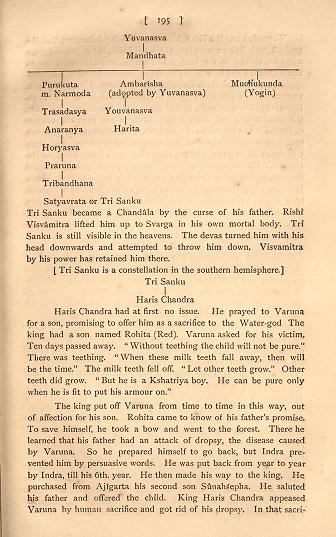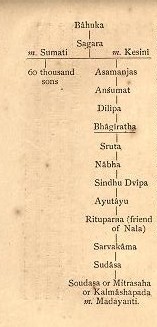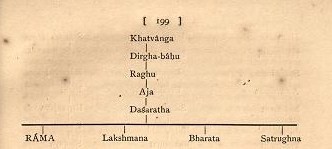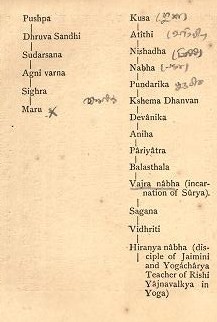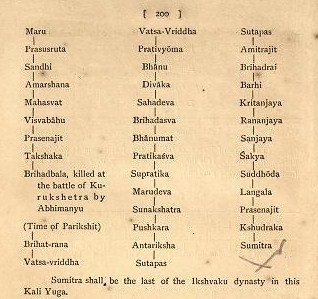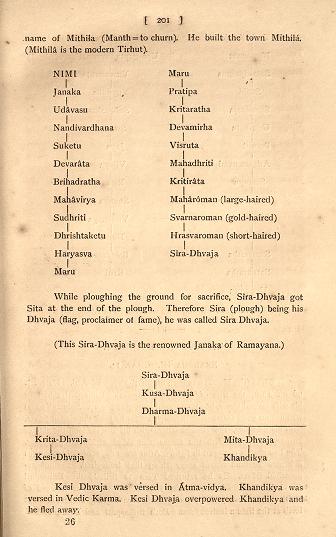
| SURYA VANSH Suryavansh / Solar Dynasty is one of the types of Kshatriyas. These Kshatriya communities claim descent from Surya. James Tod places it in the list of Thirty Six Royal Races.
One of sons of Brahma was Mareechi, whose grandson was Vivasvan, from whom started Suryavansh. According to Thakur Deshraj the kshatriyas who followed Solar calender for the calcultion of time were called Suryavanshi. Ram was born in Suryavansh.
History
:
Historians of the Rajput period have called the Ikshwaku group as Surya Vanshi and the Buddh group as Chandra Vanshi, corresponding to the Sun and Moon. Their origin has been linked with Brahma the creator of the universe. The following genealogical tree was drawn out.
Bramha had 10 manasputra (mind born sons) which are Angiras, Atri, Bhrigu, Kratu, Mareechi, Narad, Pulatsya, Pulah, Vashishth and Daksh.
Surya Vansh starts from Mareechi :
Mareechi had son named Kashyap, Kashyap had son named Vivaswan, Vivaswan had son named Manu, and many had son named Ishvaku.
Chandra Vansh starts from Atri :
Atri had a son named Chandra, Chandra had a son named Buddh, Buddh had a son named Pururava, Pururava had a son named Ayu, Ayu had a son named Nahush and Nahush had a son named Yayati.
Yayati had 5 sons named Anu, Puru, Drahyu, Yadu and Turvasu.
Bhagavat Puran :
Sraddhadev Manu had no child for sometime. Vasisth per formed a sacrifice in honor of Mitra-varun that he might obtain progeny. Sraddha, wife of the Manu, went to the chief priest and asked for a daughter. So Manu had a daughter named Ila. He took Vasisth to task for having had a daughter. Vasisth thought the priest had done something wrong. He prayed to Bhagvan for the change of Ila's sex. So Ila became a male named Sudyumna and in company with others went on horse back to the chase. He entered a forest called Sukumar, below the Meru, which is the play ground of Shiv and his consort. He and his companions were all transformed into females, for such is the mandate of Shiv for those that enter the forest. In this changed condition, Sudyumna with his female companions went to Buddh. Buddh took a fancy for Sudyamna and had by her one son Pururavas.
Vasisth took pity on Sudyumna again and prayed to Shiv to change his sex. By the favour of Shiv, Sudyumna became a male for one month and a female for another month. He had three sons : Utkala, Gaya and Vimala.
Ikshavaku
Brothers :
Manu
1. Prishadhra :
While residing in the house of his Guru, Prishadhra was placed in charge of cattle. It was raining one night, when a tiger entered the fold. The cattle strayed about in fear and bellowed aloud. Prishadhra ran after the tiger. The night was dark. He missed his aim and cut off the head of the cow, which the tiger had seized. He found out the mistake in the morning and informed his Guru about it. The Guru said : " You shall become a Sudra, as the fruit of your Karma." Prishadhra accepted the curse. He be came an ascetic, and roamed about the earth as the friend of all beings. Eventually He ended his life in fire.
2. Kavi :
Kavi attained wisdom in his youth. He did not marry.
3. Karush :
The sons of Karush were the Karushs, a race of pious Kshatriyas, who guarded the north.
4. Dhrisht :
Dharshts were the sons of Dhrisht. Though born as Kshatriyas, they became Brahmans on this earth.
5. Nrig :
Nrig → Sumati → Bhutajyoti → Vasu → Pratika → Oghavat → Oghavat + Oghavati (m.Sudarshan)
Ancestry of Nrig as per Bhagvat Puran 6. Narishyant :
Narishyant → Chitra Sen → Riksh → Midhvat → Purna → Indra Sen → Vitihotra → Satya-Sravas → Uru-Sravas → Devdatt → Agnivesya (Incarnation of Agni also known as Kanina and Jatu-Karna) → Agni veshyayan Brahmans.
7. Drisht :
Disht → Nabhag (became a Vaisya by his karma) → Bhalandan → Vatsapriti → Pransu → Pramati → Khanitra → Chakshush → Vivinsati → Rambha → Khaninetra (very pious) → Karandham → Avikshit → Marutt.
Sambart, Son of Angiras, officiated at the Yajna performed by Marutt. The Devs took direct part in the Yajna.
8.
Marutt :
Ancestry of Marutt as per Bhagvat Puran 9. Saryati (Skandh IX. Chap. 3) :
Saryaji was well versed in the Vedas. He had one daughter, Sukanya. He went with her one day to the Asham of Chyavan Rishi. Sukanya found there two streaks of light as from glow-worms, issuing from within a mound of earth, thrown up by white ants. She pricked those portions with a thorn and blood oozed out. The party of Saryati found that their usual secretions were stopped. The king thought some one had offended Chyavan. The girl then told her story. The king found the Rishi underneath the mound of earth and asked his pardon. The Rishi wanted the hand of the girl in marriage and Saryati consented. So Sukanya became the wife of Chyavan.
One day the Ashvini Kumaras came to Chyavan. The Rishi asked them to give him youth and beauty and promised in return to give them offerings of Som, though they had no part in Som Yagas. The Ashvini Kumars took the Rishi inside a tank and all the three came out young and beautiful and looking all alike. Sukanya could not recognise her husband and she prayed to the Ashvini Kumars to remove her confusion. They were pleased with her chastity and pointed out her husband.
One day king Saryati came and found his daughter sitting with a young man. He reproved Sukanya for her supposed unchastity. The girl then related the story of her husbands attaining youth and the king became very much pleased.
Chyavan made offerings of Som to the Ashvini Kumars. This offended Indra. He held up the Vajra to kill Chyavan, but the son of Bhrigu paralysed the hands of Indra. From that time the Devs consented to give a share in Som for the Ashvini Kumars.
Saryati → Sukanya (m. Chyavana) + Uttanavarhi + Anarta + Dhuri Sena
Anart → Revat (He built a town called Kusasthali in the midst of the sea and from that town ruled Anart and other lands.) → Kakudmin → Revati
Kakudmin took his daughter Revati with him and went to Brahma lok to enquire of Brahma, who should be her husband. The Gandharvs were singing at the time and Kakudmin had to wait for a moment. He then saluted Brahma and made the enquiry. Brahma laughed and said: " O king, the men of your choice are dead and gone. I do not hear even of their sons and grandsons. Twenty seven yug cycles have now passed away. Therefore go back to thy place and give thy daughter to Baldev, who has now incarnated as an Ansh (part) of Vishnu for the good of Bhur-lok. And so the king did. (The Present is the 28th. Yug cycle. Baldev is the brother of Sri Krishna.)
10.
Nabhag :
Nabhag → Ambarish (+ Ketumat + Sambhu) → Virup → Prishdasv → Rathitar
Rathitar had no children. At his request Rishi Angiras produced certain sons by his wife. They were known both as Rathitars and Angiras.
Ancestry of Ikshvaku as per Bhagvat Puran Ikshvaku (Skandh IX. Chaps 6-13) :
Ikshvaku was born out of the nostrils of Manu when sneezing. He had one hundred sons. Vikukshi, Nimi, and Dandaka were the eldest born. Twenty five of them ruled on the east of Aryavart, twenty five on the west and twenty five in the middle. The others ruled else where. For the performance of Ashtak Sraddh, Ikshvaku once ordered [Vikukshi]] to get some good flesh. Vikukshi had a bagful of good game. But he was hungry and ate one rabbit out of his store.
Vahishth found fault with this and Ikshvaku had to reject the whole of the game. The King became angry at this and he expelled his son from the kingdom. When Ikshvaku died, Vikukshi returned. He succeeded his father as king and was known as Sasad or Rabbit-eater. Puranjay was the son of Sasad. He was also called Indravah and Kakutsth. The Devs had a fight with the Asurs and Indra asked for the help of Puranjay. Puranjay wanted Indra to be his carrier, and the King of the Devs became a bull. Puranjay ascended the bull on its hump. He is therefore called Indra-vah or Indra-vehicled and Kakutsth or the mounter on the hump. He defeated the Asurs.
Ikshvaku → Vikukshi (Sasad) (+Nimi + 98 other sons) → Puranjay (Indra vahu Kakutsth) → Anen → Prithu → Visvagandhi → Chandra → Yuvanshva → Sravast (He built the town Sravasti) → Brihadasva → Kuvalayasv (Dhundhumara)
With his 21 thousand sons, Kuvalayasva killed an Asur called Dhundhu, for the good of Rishi Utank. But the Asur killed all his sons, except three, with fire from his mouth. Those three were Dridhasva, Kapilasva and Bhadrasva.
Kuvalayasva (or Dhundhumar) → Dridhasva (+ Kapilasva + Bhadrasva) → Haryasva → Nikumbh → Bahulasva → Krisasva → Senajit → Yuvanasva
Yuvanashva
:
Mandhat :
Mandhat Ancestry Yuvanasva, by the blessing of the Rishis, did not meet with death at delivery. Mandhat was a very powerful king. The thieves dreaded him much. He performed many sacrifices and made many gifts. He married Indumati, daughter of Sasabindu. He had three sons Purukutsa, Ambarish, and the Yogin Muchukund. He had also fifty daughters.
Rishi Soubhari made Tapas in the "waters of the Yamuna. One day he saw the pairing of a couple of fish and became excited. He requested king Mandhat to give him one daughter in marriage. The king said : " By Svayamvara, you may get my daughter " (i. e. the girl must choose her own husband from amongst a number of men offering themselves as husbands.) The Rishi thought because he was old and decrepit therefore the king wanted to put him off. So Soubhari by yogic powers became young and beautiful. All the fifty daughters then accepted him for their husband. The Rishi prepared for himself all the enjoyments of life and passed his days in company with his 50 wives. He then became disgusted with this sensual life and afterwards attained Moksh with his wives.
Yuvanasva adopted his grand son Ambarish. Ambarish had one son Youvanasva. His son was Harit. These three, Ambarisha, Youvanasva and Harit were the founders of the chief clans of the Mandhat Dynasty.
The elemental serpents gave their sister Narmod in marriage to Purukuts. Purukuts accompanied Narmod to Rasatal at the request of Vasuki. There he killed such Gandharvs as deserved to be killed. Those who remember this story have no fear from serpents. Such was the blessing of the elemental serpents.
Yuvanasva → Mandhat → Purukut (m. Narmod) (+ Ambarish + Muchukund:Yogin) → Trasadasya → Anaranya → Horyasv → Prarun → Tribandhan → Satyavrat or Tri Sanku → Harishchandra
Mandhat → Ambarish (adopted by Yuvanasv) → Youvanasv → Harit
Tri Sanku became a Chandal by the curse of his father. Rishi Visvamitra lifted him up to Swarg in his own mortal body. Tri Sanku is still visible in the heavens. The devs turned him with his head downwards and attempted to throw him down. Visvamitra by his power has retained him there. [Tri Sanku is a constellation in the southern hemisphere].
Harishchandra had at first no issue. He prayed to Varun for a son, promising to offer him as a Yagya to the Water-god. The king had a son named Rohit (Red). Varun asked for his victim. Ten days passed away. "Without teething the child will not be pure." There was teething. " When these milk teeth fall away, then will be the time." The milk teeth fell off. "Let other teeth grow." Other teeth did grow. " But he is a Kshatriya boy. He can be pure only when he is fit to put his armour on."
The king put off Varun from time to time in this way, out of affection for his son. Rohit came to know of his father's promise. To save himself, he took a bow and went to the forest. There he learned that his father had an attack of dropsy, the disease caused by Varun. So he prepared himself to go back, but Indra prevented him by persuasive words. He was put back from year to year by Indra, till his 6th year. He then made his way to the king. He purchased from Ajigart his second son Sunahseph. He saluted his father and offered the child. King Harishchandra appeased Varun by Ashwamegh Yagya and got rid of his dropsy.
In that sacriffice, Visvamitra was the Hota, Jamadagni was the Adhvaryu, Vasistha Brahma and Ayasya was the Udgat. Indra being pleased gave a golden chariot to the king. Visvamitra taught Atma Vidya to Harishchandra and he attained liberation.
[The story of Harishchandra in this Puran follows the vedic version. The gist of the story is that in the course of further evolution the Devas were to be propitiated by human sacrifice. But this sacrifice did not mean killing. It was the complete offering of oneself up. to the service of the gods. The mission of the human victim is to constantly work for the good of the Universe and to extinguish his own personality. Sunah Sepha was not killed in the sacrifice. He was offered up to the service of the gods. After the sacrifice, he was called Devarat i.e. one offered to the Devs. Visvamitra adopted Devarat as his own son and he asked his hundred sons to accept him as their eldest brother. He disowned those sons that did not obey him (Bhagavata IX- 16). Therefore Visvamitra took the principal part in this sacrifice and not Vasisth, though he was the family preceptor.]
Harishchandra → Rohit → Harit → Champa (Founder of Champa) → Sudev → Vijay → Bharuk → Vrik → Bahuk
Ancestry of Bahuk as per Bhagvat Puran His enemies dispossessed Bahuk of his kingdom. He went to the forest accompanied by his wives. When he died, the eldest queen prepared herself for death also. Rishi Aurv knew her to be big with child, and dissuaded her from accompanying her husband on to the funeral pyre. The co-wives of the queen, out of jealousy, gave her poison. The child was born with this poison, therefore he was called Sagar (Sa = with, gar = poison.) Sagar became a great king. The Seas were dug by his sons. He was prevented by Rishi Aurv from taking the lives of the Talajanghs, Yavan, Sakas, Haihayas, and Barbars. But he made them change their outward look. He performed an Ashwamegh sacrifice as advised by Aurv and Indra stole the horse.
Bahuk → Sagar (m.Kesini) → Asamanjs → Ansumat → Dilip → Bhagirath → Srut→ Nabh → Sindhu Dvip → Ayutayu → Rituparn (Friend of Nal) → Sarvakam → Sudas → Soudas or Mitrasah or Kalamasapada (m.Madayanti)
Sagar had two wives Sumati and Kesini. The 60 thousand sons of Sumati searched for the horse on all sides. They dug the earth's surface and made the Seas. They found the horse near Kapil. They took him to be the stealer of the horse and abused him. For this they were all burnt up.
Kesini had one son Asamanjas by Sagar. Ansumat was son of Asamanjas. He was attached to his grandfather Sagar. Asamanjas was a Yogin in his former birth. He therefore wanted to avoid company by means of provoking acts. He threw down some children into the Saraju. His father Sagar was thus compelled to forsake him. By Yogic powers, be brought back the children thrown into the Saraju, and left his father for ever.
Ansumat was also sent by Sagar to search for the horse. He found the horse and a heap of ashes near Kapil. He saluted Kapil and glorified him. The Avatar was pleased. He permitted Ansumat to take away the horse. He also informed him that his burnt-up Pitris could only he saved by the water of the Ganga.
Sagar completed the Ashwamegh Yagya with the horse. He made over the kingdom to Ansumat and attained Mukti.
Ansumat made Tapas for the downward flow of Ganga but without success. He was followed by his son Dilipa. He also did not succeed. Bhagirath was the son of Dilip. He prayed hard and Ganga appeared in person before him. "Child, I am pleased with thee. What boon do you ask for"? Bhagirath told her what he prayed for. "But who shall arrest my course, when I fall down. If not arrested I will pierce the earth and reach Rasatal. Again if I pass over earth, men will wash away their sins in my waters. Where shall I wash away those sins, O King ? Therefore do thou ponder well what to do." Said Bhagirath : "The touch of Sadhus shall take away thy sins. For Vishnu, the destroyer of sins, remains in them. Thy downward course shall be arrested by Rudra." Shiv was pleased by the prayer of Bhagirath, and he consented to hold Ganga.
Ganga came rushing down and she was taken by Bhagirath to where the ashes of his Pitris lay. The very touch of her waters purified the sons of Sagar and they went to Swarg.
Once there lived two Rakshashs. Soudas killed one and did not kill the other. The surviving Rakshash, bent on taking revenge, entered the service of Soudas as a cook. When the king entertained Vasisth, he gave him human flesh to eat. The Rishi became angry and caused Soudas to become a Rakshash. When he learned however it was the doing of a Rakshash, he reduced the king's Rakshash life to 12 years. The king also held out water for the execration of Vasisth. His queen prevented him. So he threw the water at his own feet. His feet became black with sin. While living as a Rakshash, the king saw a Brahman and his wife in their privacy, and he attacked the Brahman. The wife reminded the king of his former birth and requested him not to deprive her of her husband at the time of enjoyment. The king heeded not her words but devoured the Brahman. The Brahman woman cursed Soudas so that he should meet with death whenever he had female connection. On the expiry of 12 years, Soudas reverted to his former birth, but for fear of the curse he had no connection with women. Vasisth at the request of Soudas produced a son by his wife, Madayanti. The conception lingered for 7 years. Vasisth struck the womb with a stone (Asman) and the son was hence called Asmak. The son of Ashmak was Balik. He was the surviving Kshatriya, after the extirpation of that caste by Parashuram. Hence he was called Mulak also (the root of a race).
Soudas → Ashmaka → Balik or Mulak → Dasharath → Aidavidi → Visvasah → Khatvang
Ancestry of Khatvang as per Bhagvat Puran Khatvang was a very powerful king. He killed Daityas as a friend of the Devs. The Devs offered him a boon. The king wanted to know how much longer he was to live. Learning it was a Muhurt only, he returned forthwith to his place and concentrated his mind on Bhagvan. He attained Mukti.
Dasharath Ancestry :
Khatvang → Dirgh-bahu → Raghu → Aja → Dasharath → Ram + Lakshman + Bharat + Satrughna
Ancestry of Dashrath as per Bhagvat Puran
Ancestry of Kush as per Bhagvat Puran
Ancestry of Langal in Bhagavat Puran The story of Ram as told in the Ramayan is widely and universally known. It is therefore unnecessary to repeat that story from the Bhagavat Puran.
Raghu → Kush + Lav
Lakshman → Angad + Chitraketu
Bharat → Taksh + Pushkal
Satrughna → Subahu + Srut sen
Kush → Atithi → Nishadh → Nabh → Pundarik → Kshem Dhanvan → Devanik → Anih → Pariyatra → Balasthal → Vajra Nabh (Incarnation of Surya) → Sagan → Vidhriti → Hiranya Nabh → Pushp → Dhruv Sandhi → Sudarshan → Agni Varn → Maru → Prasusrut → Sandhi → Amarshan → Mahasvat → Visvabahu → Prasenajit → Takshak → Brihadbal (killed at the battle of Kurukshetra by Abhimanyu).
(Time of Parikshit)
Brihat-ran → Vats-vriddh → Prativyom → Bhanu → Divak → Sahdev → Brihdasva → Bhanumat → Pratikasva → Supratik → Marudev → Sunakshatra → Pushkar → Antariksh → Sutaps → Amitrajit → Brihadrai → Barhi → Kritanjay → Rananjay → Sanjay → Shakya → Suddhoda → Langal → Prasenajit → Kshudrak → Sumitra
Sumitra shall be shall be the last of Ikshvaku dynasty in this Kaliyug.
The Rishis churned the body of Nimi and a son was born. He was called Janak. As he was born, when his father was bodiless (videh) he was also called Vaideh.
Ancestry of Nimi in Bhagavat Puran The churning also gave him the name of Mithila (Manth = to churn). He built the town Mithila. (Mithila is the modern Tirhut).
Nimi → Janak → Udavasu → Nandivardhan → Suketu → Devrat → Brihadrath → Mahavirya → Sudhriti → Dhrishtaketu → Haryasva → Maru → Pratip → Kritarath → Devamirh → Visrut → Mahadhriti → Kritirat → Maharoman (large-haired) → Svarnaroman (gold-haired) → Hrasvaroman (short-haired)→ Sira-Dhvaj
While ploughing the ground for sacrifice, Sir-Dhvaj got Sita at the end of the plough. Therefore Sir (plough) being his Dhvaj (flag, proclaimer of fame), he was called Sir Dhvaj. (This Sir-Dhvaj is the renowned Janak of Ramayan).
In the ancestry of Sir-Dhvaj were Sir-Dhvaj → Kus-Dhvaj → Dharma-Dhvaj → Krit-Dhvaj + Mit-Dhvaj
Kesi-Dhvaj from Krit-Dhvaj was versed in Atma-vidya and Khandikya from Mit-Dhvaj was versed in Vedic Karma. Kesi Dhvaj overpowered Khandikya and he fled away.
Kesi-Dhvaj → Bhanumat → Sat-dyumna → Suchi → Sanadvaj → Urja-ketu → Purujit → Arisht nemi → Srutayu → Suparsva → Chitrarath → Kshemadhi → Samarath → Satyarath → Upa-guru → Upa-gupta (incarnation of Agni) → Vasvanant → Yuyudha → Subhashan → Srut → Jay → Vijay → Rita → Sunak → Vitahavya → Dhriti → Bahulasva → Kriti
These kings of Mithila were well versed in Atma-vidya.
The
great Suryavanshi kings :
•
His sons from Aditi or Adityas (Sons of Aditi) were, Amsa, Aryaman,
Bhaga, Dhuti, Mitra, Pusan, Sakra, Savitr, Tvastr, Varun, Visnu,
and Vivasvat or Vivasvan , who went on to start the Solar Dynasty
(Suryavanshi), which later came to be known as Ikshvaku dynasty,
after his great grandson, King Ikshvaku, whose subsequent kings
were, Kukshi, Vikukshi, Bana, Anaranya, Prithu, Trishanku, and finally
King Raghu, who gave it the name, Raghuvansh (Dynasty of Raghu),
and then further leading up to Lord Ram, the son of Dashrath.
Karush :
Narishyant, in Hindu mythology, was son of Vaivasvat Manu and belongs to solar race of Kshatriyas. Nehra Jats are said to be descended from him.
From 'Kakusth' started a Jat vansh known as 'Kusth' or Kakvansh. This later changed due to language variations to 'Kakusth', Kak, Kaktiya, Kakka, Kuk, Kukkur, Kak and Kakaran. In this very clan was born Dashrath's grandfather Raghu who started Raghuvansh. Raghuvanshi Jats are also descendants of him who are also known as 'Raghuvanshi Sikarwar’. During Ramayan period, in Valmiki Ramayan, Dev Samhita, Vishnu Puran, Shiv Puran, Veds, etc there is mention of Jats and their republics at various places. Jatvansh joined his army of Vashishth Rishi in his support and fought war with Vishvamitra. This was a very severe war in which thousands of Jat soldiers were killed.
Bhaleram Beniwal has provided evidences from ‘Bal Kand (ekonavish sarga shlok-16, dvavish sarga shlok-6’, dvavish sarga shlok-20, panchvish sarga shlok-15, pratham sarga shlok-56) to prove that Dashrath and his son Ram were ‘kakusth’ and Raghuvanshi Jats. Ram has been addressed by the names Raghunandan, Raghukul, Kakasthkul, and Raghuvanshi. Later Lav, elder son of Ram started Lamba gotra in Jats and Kush started Kachhavahi or kushvansh whose descendant Brahdal was killed by Abhimanyu, son of Arjun. Suryavanshi kushvansh Jats ruled Ayodhya from 3100 BC to 500 BC. In the 21st generation of Ikshvaku was born Mandhat who has been written and proved as Gaurvanshi Jat in genealogy of Suryavanshi kings. One of sons of Mandhat was Ambarish. His son was Yuvanashva and his son was Harit, who was a great Rishi. The descendants of this king became Brahman who were known as Gaur Brahmans.
Kuvalyashva
:
Mandhat
:
The most prominent among the sons of Mandhat was he who is celebrated as Ambarish. Ambarish was accepted as son by his grandfather Yuvanasva. Ambarish's son was Yauvanasva, and Yauvanasva's son was Harit. In Mandhat's dynasty, Ambarish, Harit and Yauvanasva were very prominent.
Bharuk (42)
Vrik (43)
Bahuk (45)
Bharat (46)
Asit (42)
Sagar
:
Later King Sagar sent his grandson Anshuman to retrieve the horse. Kapil returned the horse and told Amsuman that the sons of King Sagar could be delivered if the Ganges descended to earth and bathed them in her waters. King Sagar’s great-great-grandson, Bhagirath, eventually pleased Mother Ganga, and asked her to come to earth. Mother Ganga told Bhagiratha that the force of the Ganges falling from heaven would be too great for the earth to sustain, and that she needed someone to break the fall. Bhagirath then worshiped Lord Shiv, who then agreed to accept the descending river upon his head.
King Bhagirath then preceded the holy river with his chariot and ripped open a gorge in which the Ganga (Ganges) could flow. The river followed the King to Ganga Sagar at the Bay of Bengal, where Kapil resides. The Ganga River then bathed the remains of the 60,000 sons and returned them to their eternal positions.
Dilip
:
Bhagirath
:
Kakuts (54)
Nabh (56)
Nal - Nal was a Suryavanshi Kachhawah Jat whose capital was Narwar
Ashmak (65)
Dasharath (77)
Takshak
:
Langala
Source :
https://www.jatland.com/ |
